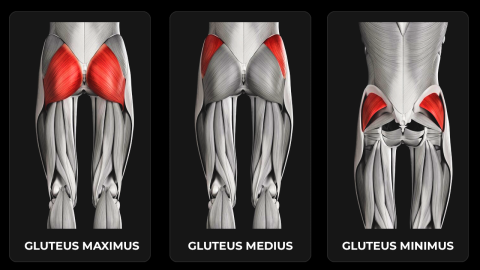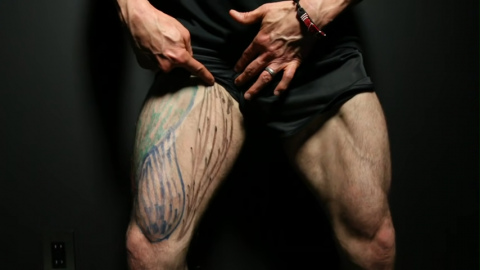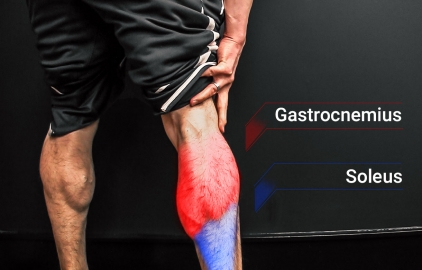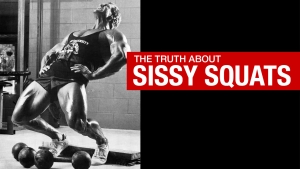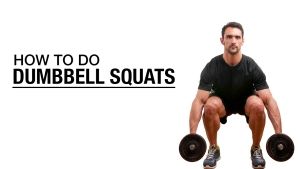
MASTERING THE BULGARIAN SPLIT SQUAT
It seems like everywhere I turn, someone’s attempting the Bulgarian Split Squat in popular workouts — my absolute favorite leg exercise — and frankly…
It’s a disaster.
As a personal trainer, I can’t just stand by and watch this travesty unfold. It’s high time I stepped in and showed you how it’s really done.
Believe it or not, 90% of the issues with this exercise arise from a shoddy setup.
If you can master those initial steps to Bulgarian Split Squats, the rest of it – perfect and proper squat form – will easily fall into place within an efficient workout.
From the anatomy to the exercise breakdown, let’s take a closer look at how to do Bulgarian Split Squats.
WHAT MUSCLES DOES THE BULGARIAN SPLIT SQUAT WORK?
The Bulgarian Split Squat is not your average squat.
And let’s be clearer, this is NOT a Single-Leg Squat.
A dynamic, compound movement, the Bulgarian Split Squat exercise tests your balance, fires up your abdominal muscles, and pushes your leg muscles to their limits.
The Bulgarian Split Squat demands precision, control, and understanding the mechanics of your body.
The rule of thumb is to learn which muscles single-leg exercises like this target before we learn how to do it.
Building a strong mind-to-muscle connection will help you perform the compound exercise with proper form and reduce your risk of mistakes and injuries.
Here are the primary muscles that the Bulgarian Split Squat works:
THE QUADRICEPS
The quadriceps are comprised of four distinct heads or sections, making them the largest muscle group in the legs.
VASTUS MEDIALIS

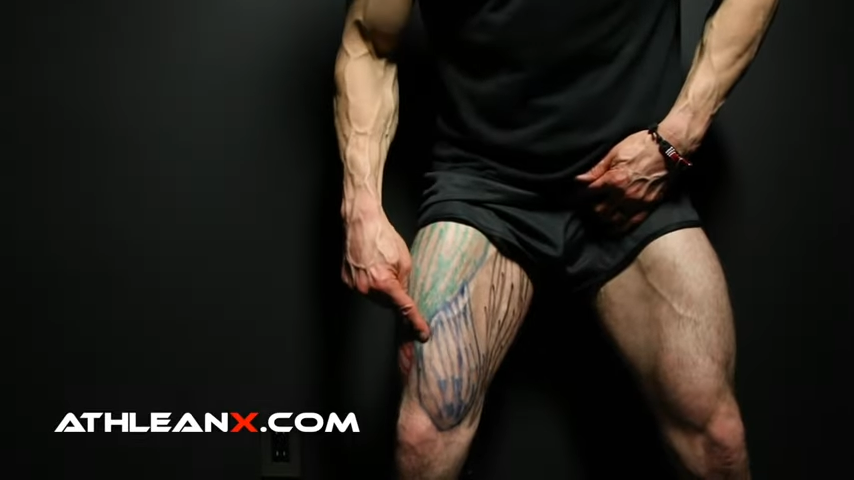
Located on the inside of the knee position, the vastus medialis serves as the medial segment of the quadriceps. Its principal role involves aiding in the extension of the knees.
VASTUS INTERMEDIUS

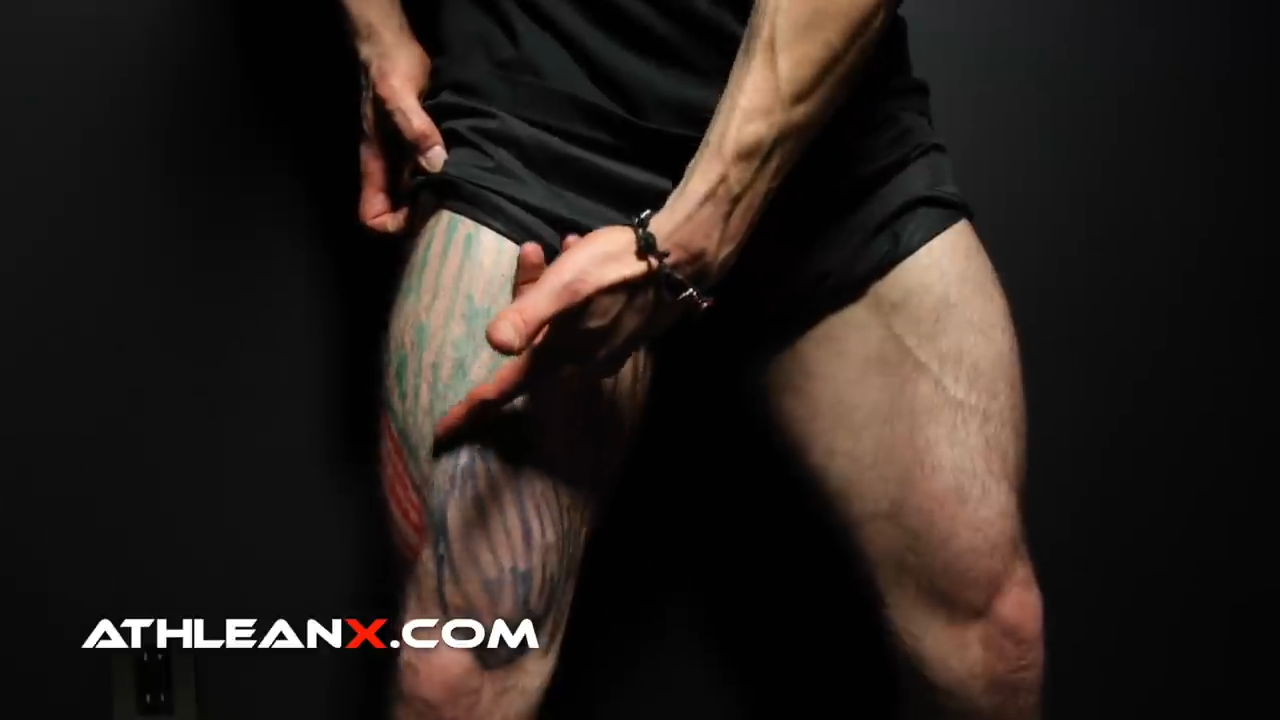
Nestled in the middle of the quad, underneath the muscle and not visible from the outside, is the vastus intermedius. It plays a key role in knee joint extension, even though it remains out of sight.
VASTUS LATERALIS


Situated on the outer side of the knees, the vastus lateralis forms the lateral part of the quadriceps muscle group. Its function aligns with the others in aiding knee extension.
RECTUS FEMORIS

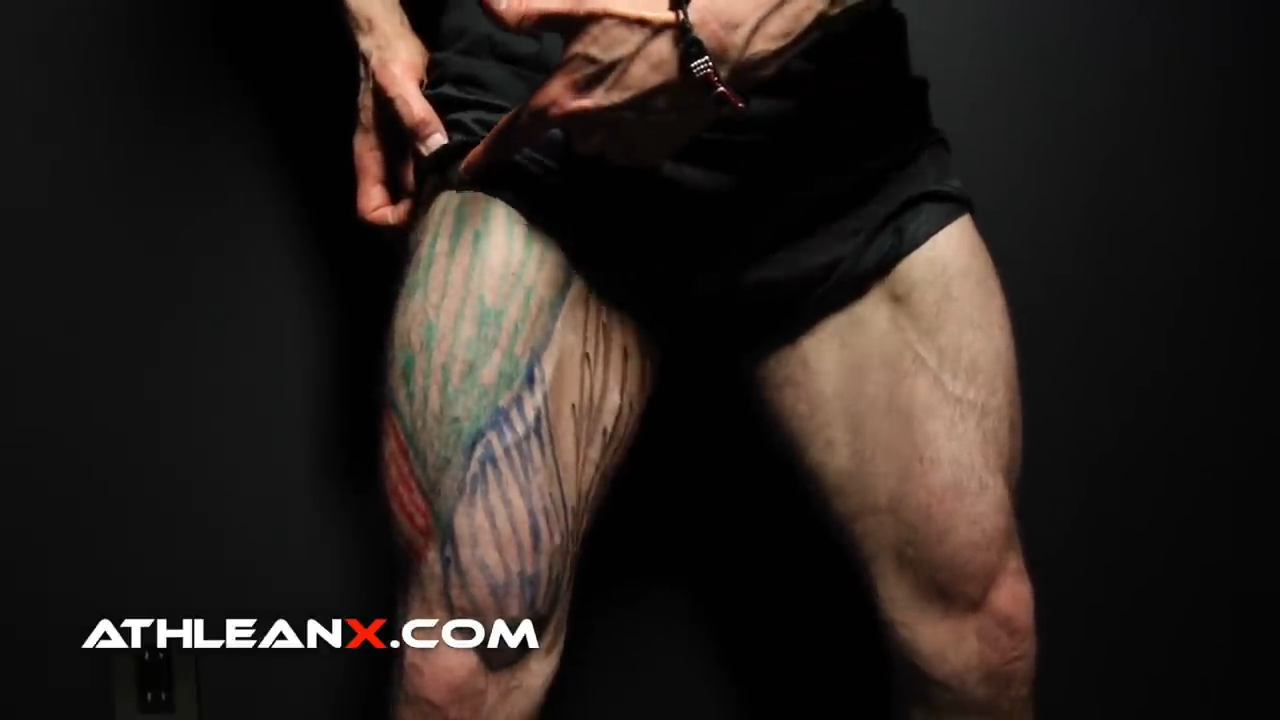
The rectus femoris stands out as the sole quad muscle attaching above the hip, which gives it a unique role in hip functionality, especially in aiding the hip’s capacity to lift into flexion.
THE GLUTES
Depending on the angle of your upper body during Bulgarian Split Squats, you can emphasize a glute-dominant Bulgarian Split Squat.
Although the gluteus maximus is what most people think of as “the glutes,” this muscle group is actually made up of three sections:
GLUTEUS MAXIMUS
The gluteus maximus, known as the primary muscle forming the shape of the buttocks, extends beyond aesthetic appeal to play a crucial functional role in various movements.
Originating from the upper hip bone and lower spine, this big powerhouse muscle attaches to the thigh, aiding in hip extension, lateral rotation, thigh abduction, postural support, and stabilizing the sacroiliac joint, which is important for lower back health and overall body alignment.
GLUTEUS MEDIUS
The gluteus medius muscle starts from the outer part of your hip bone and connects to the upper part of your thigh bone.
It’s important for everyday movements, like moving your thigh away from the center of your body, helping rotate your hip inwards and outwards, keeping your pelvis stable, and ensuring you maintain good posture, especially when you’re walking, running, or trying to balance.
GLUTEUS MINIMUS
The gluteus minimus, though the smallest of the three main glute muscles, is essential for hip movement, balance, and overall muscle development.
It starts from the lower hip bone, connects to the upper thigh, and helps in sideways leg movements, turning the thigh inward, stabilizing the pelvis, and supporting good posture, especially when walking, running, or standing on one leg.
THE HAMSTRINGS
Turn your attention to the back of your legs, and there you’ll discover the hamstrings, which consist of two main bundles of muscle fibers.
BICEPS FEMORIS


The adductor muscles originate from the pelvis and extend down the inner thigh, playing a key role in bringing the legs together and assisting in hip stabilization.
These muscles are essential for activities such as walking and running. Strengthening them can make up for a lack of balance.
THE ABDUCTORS
The abductor muscles are on the outer side of your legs and need specific exercises to train them properly.
HIP ABDUCTORS
The abductor muscles are often overlooked and end up weaker than they should be, but it’s important not to ignore them.
These muscles are responsible for moving your legs out to the side and provide essential stability when you’re doing exercises on one leg.
THE CALVES
Now we reach the lower part of the leg where the calves are located, comprising two sections: the gastrocnemius and the soleus.
GASTROCNEMIUS
The gastrocnemius muscle, the most prominent part of the calf, originates from just above the knee on the femur and extends down to the heel.
It helps with movements like walking, running, and jumping by enabling the bending of the knee and the downward motion of the foot.
SOLEUS
The soleus muscle sits behind the more famous gastrocnemius in the calf. Though the gastrocnemius is known for its size, it’s thanks to the soleus.
By building up the soleus, which starts higher up in the calf, you can push the gastrocnemius outward, giving your entire calf a larger and more developed appearance.
proper form for BULGARIAN SPLIT SQUATS
Now that you know which muscles are targeted during Bulgarian Split Squats, we can jump into learning how to perform them.
I can’t stress the emphasis on form enough with this technically complicated movement.
I’m going to break down how to do Bulgarian Split Squats step-by-step and give you form cues to help you avoid common mistakes.
FRONT FOOT SET-UP

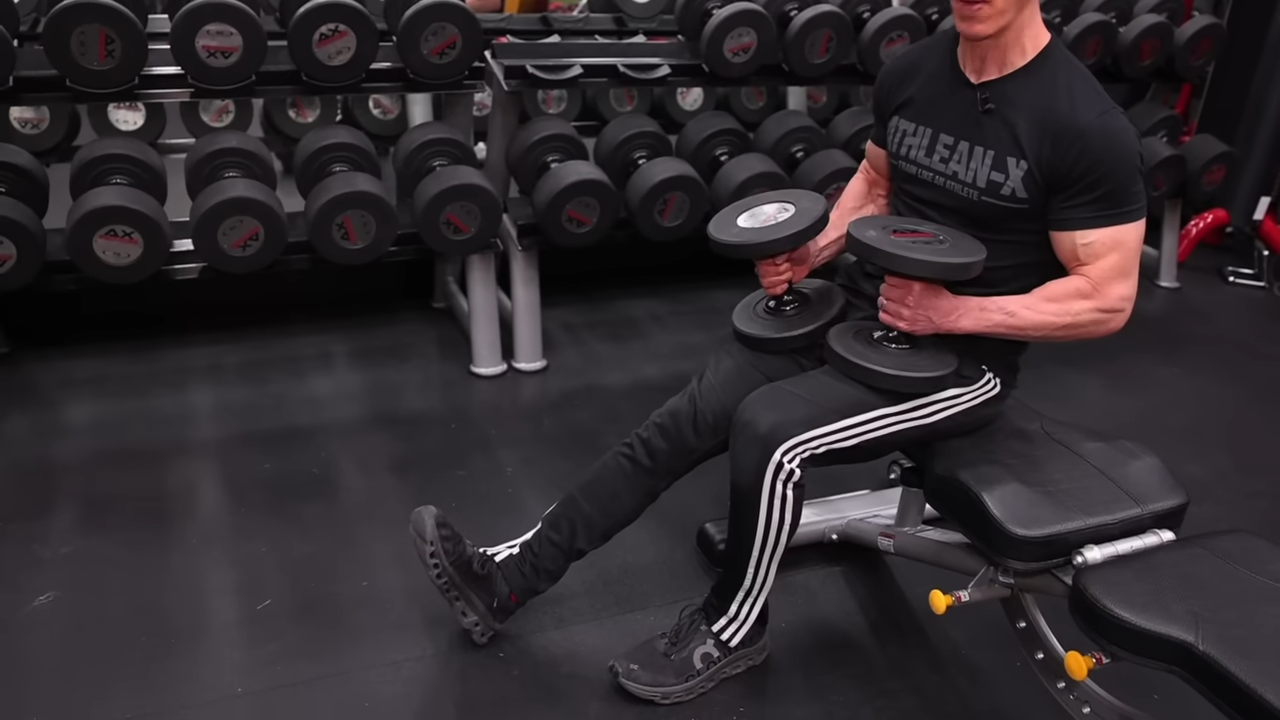
Before you even sink down into a single rep, you want to start out with proper foot placement.
You should sit on a weight bench with the dumbbells on your thighs. From here, extend one leg out. Left foot or right – whatever your preference is.
And when you do, move it just a little bit more to the outside, because that heel position is where your foot is going to go.
If your front foot is too much on the inside of your body position, you’ll have a tough time staying on that straight knee track and you’ll be at risk for knee wobble.
DUMBBELL PLACEMENT

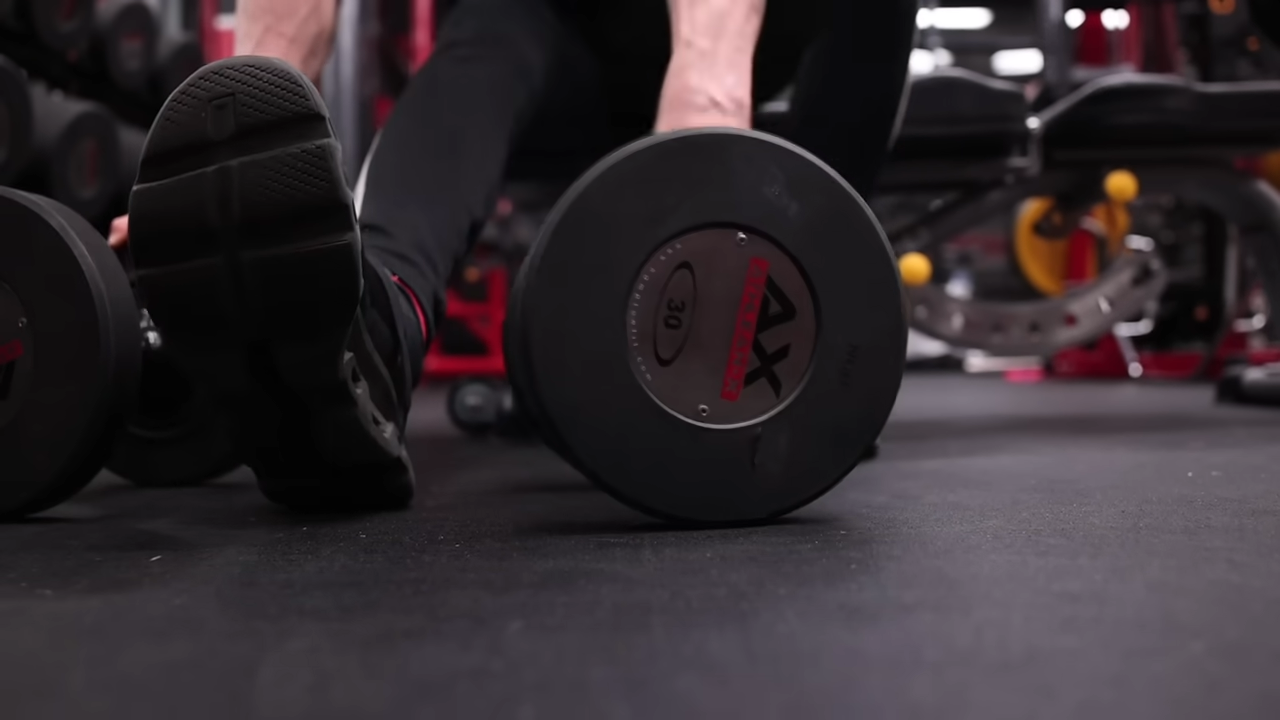
This is one of the biggest mistakes I see: not putting your dumbbells in the right place.
Put your dumbbells down on either side of the front foot alignment. When you stand up, you’ll maintain that same heel position.
BACK FOOT POSITION


Before you pick up the dumbbells, you’ll want to focus on what the back foot is doing.
You probably already know that you have to put the back foot on the bench or an elevated surface. But you might be asking…
“How exactly do I put it on the bench?”
People get this wrong by putting their toe upright on the bench. The problem is you’ve got very little point of contact on the bench, meaning you’re going to have a tough time balancing.
If you just turn your foot to the side, you’ll have much more contact area, and this is going to be perfect for nice mobility and balance.
PICKING UP THE WEIGHTS


With both feet in place, you’re ready to grab those dumbbells. Remember, the dumbbells are already in place, so all you have to do is drop down and pick them up.
And by putting that front leg out to the side just a little bit, you create a little bit of a widening in your base of support.
A little more width between both legs further increases your balance.
If you’re new to this key movement, I’d consider doing the exercise without weights first.
ALTERNATE BASE OF SUPPORT


Now, for those of us who don’t want to do it on a bench, you can break out a squat rack pad and put it around a barbell that’s in a rack. Or you can place it on the barbell in a Smith machine.
The squat rack pad gives you a rotating placement for that back leg, which will allow you to smoothly go up and down without having to worry so much about that back foot placement.
While this might be easier for some, for others, this might be more of an unstable surface than you’re used to so go slow with this option.
TORSO ANGLE: ANTERIOR CHAIN (QUADS)


What comes next is your torso angle, and that determines which part of your leg you’re actually working.
Because if you want to work your quads, you’ve got to stay upright the entire time that you perform the exercise.
Staying upright is going to force that knee flexion to occur at the right angle to make the quad do most of the work.
TORSO ANGLE: POSTERIOR CHAIN


If you wanted to shift the focus to the posterior chain, all you have to do is angle your torso forward.
You’ll know that you’re doing it right because you’ll look like you’re in the beginning of a sprinter starting block.
When you angle yourself forward, it shifts the focus to the back side into the glutes. And you maintain that forward lean during the entire exercise.
DEPTH OF THE MOVEMENT

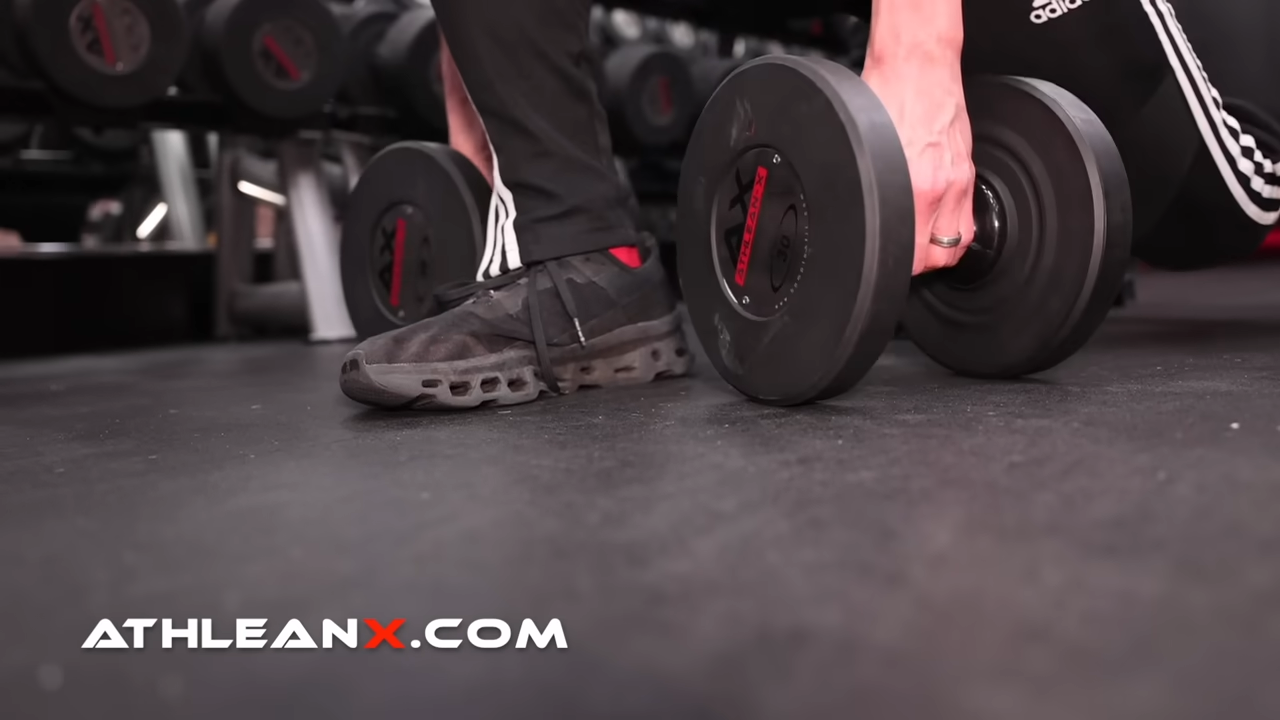
Now, as far as depth goes, you want to make sure that you’re going down to the ground with the dumbbells, but you don’t want to rest down there.
You just want to be able to make contact with the dumbbells on the ground, but still support the entire weight of the dumbbell in my hands.
From here, engage the working muscle and push yourself to the starting position.
HOW TO DO BULGARIAN SPLIT SQUATS
Guys, I know that’s a lot of information to absorb and put into practice.
I want to provide a summary of how to do this must-have exercise using the notes from above so you can tie it all together.
BULGARIAN SPLIT SQUATS

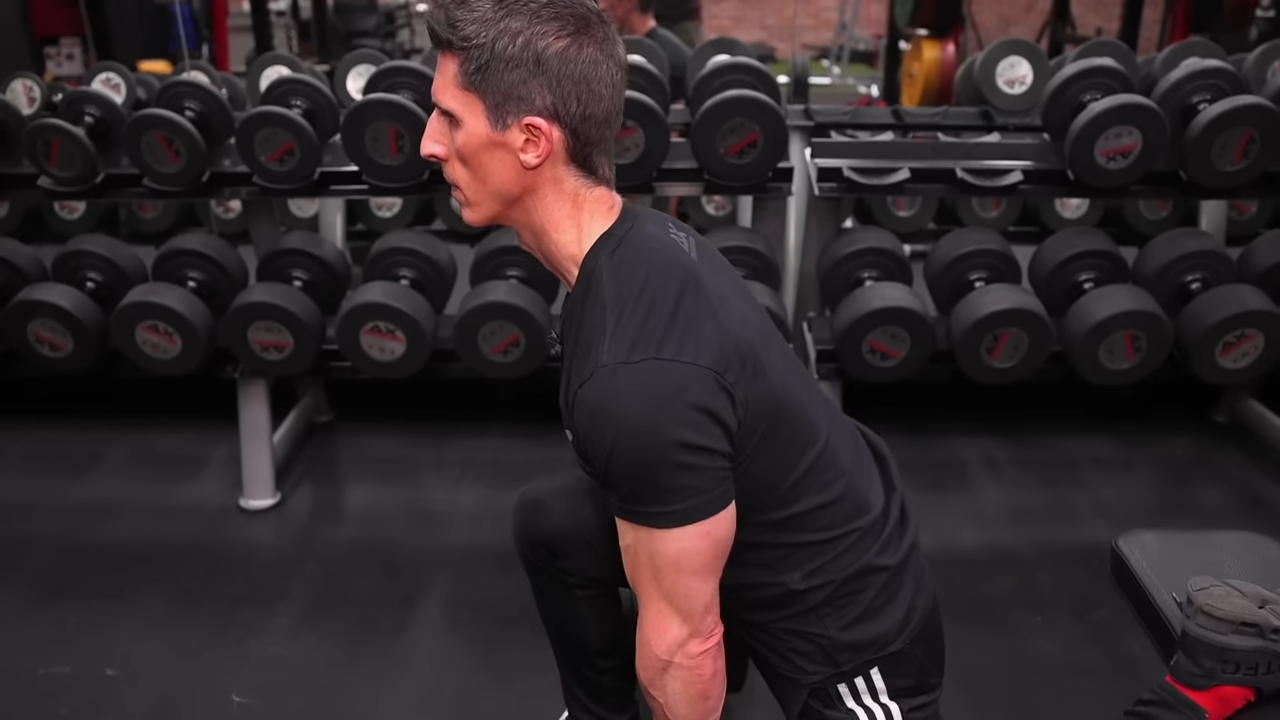
HOW TO DO BULGARIAN SPLIT SQUATS:
- Sit on a bench or stable surface with dumbbells on your thighs. Extend one leg out, moving it slightly to the outside.
- Place your dumbbells on either side of the front foot. When you stand up, maintain the same heel position.
- Place the back foot on the bench, turning it to the side rather than keeping the toe upright. This increases the contact area on the bench, aiding in balance.
- With both feet in split position and front foot flat on the floor, pick up the dumbbells from the floor.
- Keep your torso upright throughout the exercise to focus on the quadriceps. Alternatively, you can angle your torso forward to shift focus to the posterior chain, targeting the glutes.
- Lower yourself until the dumbbells make contact with the ground, but don’t rest them there. Keep supporting the weight in your hands and engage the working muscle.
- Push yourself back up to the starting position maintaining an upright posture to target the quads or a leaning forward posture to activate the glutes.
WHAT MAKES IT EFFECTIVE: This challenging compound movement is unilateral, meaning it works one leg at a time. This helps in identifying and correcting imbalances and discrepancies in muscle size between the legs, improving overall symmetry and functional leg strength. You can also perform this exercise as a Resistance Bands Split Squat or a Kettlebell Split Squat. Start with lighter weights and move on to heavier weights as you get stronger.
HOW TO MAKE BULGARIAN SPLIT SQUATS MORE INTENSE
Once you have mastered the proper form of Bulgarian Split Squats, you might be looking for an extra challenge.
Want to learn how to increase the intensity of the exercise and add an additional challenge to your workout?
Whether you want to get stronger or build more muscle mass in your lower body workout, Bulgarian Split Squats were made to accommodate intensity techniques.
Here are some challenging variations that you can do to contribute to leg and glute strength, endurance, and muscle hypertrophy:
PAUSE REPS


Pause reps involve incorporating a deliberate pause at a specific point in this effective movement, typically where the muscle is under maximum tension.
For Bulgarian Split Squats, this would usually be at the bottom of the standard squat, where your thigh is parallel to the ground or slightly lower.
Consider using a moderate load or a light dumbbell when you’re trying this for the first time, especially if you have prior knee issues. Of course, stop immediately if you feel knee pain.
Pause reps increase muscle time under tension and improve major muscle activation, leading to greater strength and muscle hypertrophy.
They also enhance control, stability, and the mind-muscle connection, aiding in overcoming sticking points in an exercise.
ONE & A HALF REPS

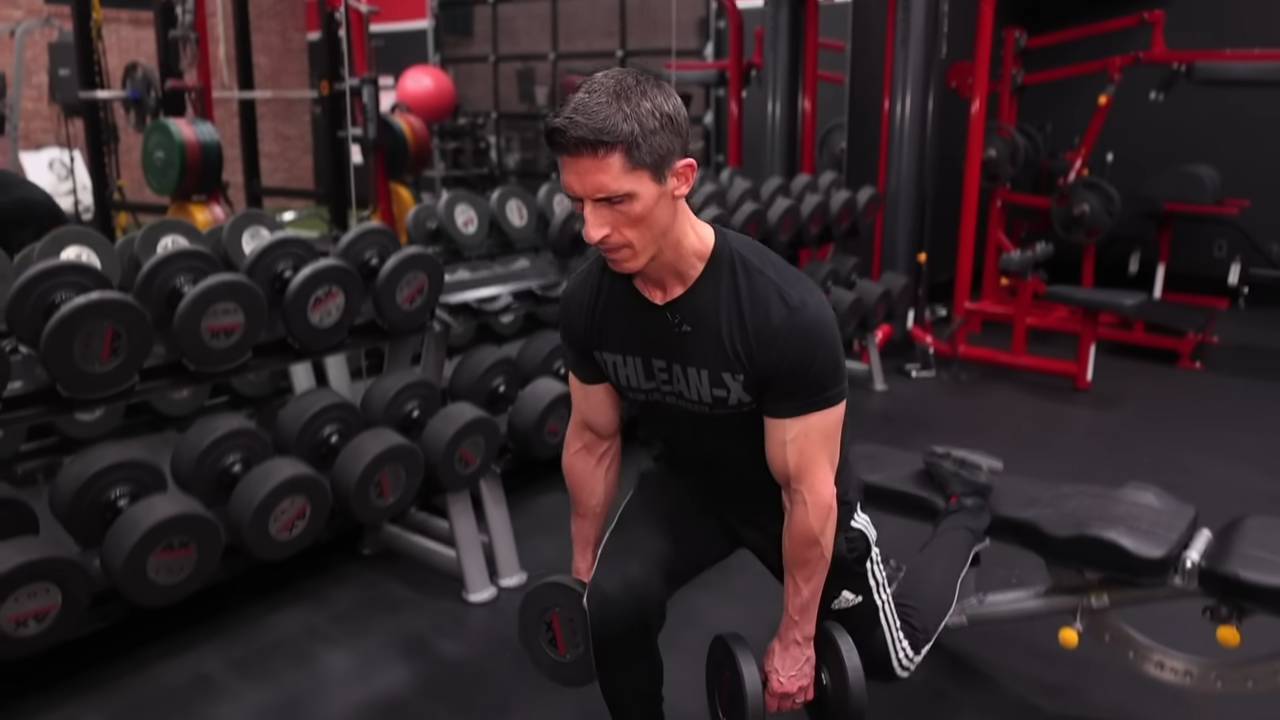
One and a half reps involve performing a full repetition of an exercise followed by a partial repetition.
In the context of Bulgarian Split Squats, after descending into the full squat and rising back up, you would then lower yourself halfway down before coming up again.
EXPLOSIVE REPS


Finally, you can do explosive repetitions as a challenging exercise variation.
Explosive reps, also known as power reps, involve performing the movement of an exercise with a burst of speed and power.
In Bulgarian Split Squats, this means descending into the squat in a controlled manner and then propelling yourself up rapidly and forcefully from the bottom position.
You can even drop the weight altogether and perform these as a bodyweight exercise: the One-Legged Plyo Bulgarian Split Squats.
The fact is, the Bulgarian Split Squat is my favorite leg exercise because of how multi-dimensional it is.
But it’s also an exercise that is performed incorrectly… a lot.
Take your time as you do this fantastic exercise and be sure to incorporate it into your current training regimen for the lower body muscles.
If you want a complete workout routine for your whole body that boosts muscle and strength, check out our ATHLEAN-X programs. We’ve got something just right for everyone, no matter what the exercise goals are or the tools you have.

- The Bulgarian Split Squat is a compound lower-body exercise that is widely attempted but often poorly executed. The success of this exercise largely depends on the correct setup. A good initial setup ensures the exercise is performed with the correct form. Follow this cue for strength exercises:
- Start by sitting on a bench with dumbbells on your thighs and extend one leg out and slightly to the side. This proper position sets the location for your front foot.
- Place the dumbbells beside your front foot. When you stand, keep your heel in this same position.
- Before picking up the dumbbells, focus on the back foot. Instead of placing your toe upright on the bench, turn your foot to the side for more contact area and better balance. With your feet correctly positioned, pick up the dumbbells.
- Keep your torso upright to target your quadriceps. Lean your torso forward to shift focus to the glutes and maintain this position throughout the movement.
- Lower to the point where the dumbbells touch the ground but don’t rest there, then push back up.
- Once you’ve mastered the form, you can increase the intensity for greater strength training and muscle growth by using pause reps, one-and-a-half reps, and explosive reps.
BULGARIAN SPLIT SQUATS FAQS
The Bulgarian Split Squat is one of the best lower body strength exercises, primarily targeting the quadriceps, hamstrings, and glutes.
It builds unilateral strength, working one leg at a time which makes it excellent for improving balance and coordination, as well as correcting muscle imbalances between the legs.
This exercise also engages the core muscles, contributing to increased abdominal and lower back strength.
Additionally, it aids in increasing hip flexor flexibility, which is beneficial for overall mobility.
Its functionality extends to mimicking everyday movements like walking and climbing stairs, thereby enhancing functional strength and endurance.
The Lunge and the Bulgarian Split Squat are both effective lower body exercises, but there are biomechanical differences in stance, muscle engagement, movement, and difficulty.
A regular Lunge involves dynamic movements, stepping forward or backward, which requires shifting body weight and engages the quadriceps, hamstrings, glutes, and stabilizing muscles.
The Bulgarian Split Squat, however, is stationary, with one elevated foot behind you on a knee-level bench, focusing more on stability in a single stance and intensifying muscle engagement, especially in the glutes and hip flexors. This exercise allows for a deep squat, emphasizing controlled, vertical movement.
While Lunges can be more beginner-friendly and adaptable by adjusting step length and depth, Bulgarian Split Squats offer more of a challenge due to the elevated rear foot, demanding greater balance and strength in the front leg.
A Dumbbell Bulgarian Split Squat is a type of squat variation and a killer leg movement. Specifically, it’s a variation of the Bodyweight Bulgarian Split Squat that incorporates the use of a pair of dumbbells to increase resistance and intensity.
You’ll perform a standard Bulgarian Split Squat - one leg forward and the other elevated behind you on a bench or similar platform - while holding a dumbbell in each hand.
The added weight of the dumbbells enhances the exercise's difficulty and effectiveness by increasing the load on the working muscles, primarily the quadriceps, hamstrings, and glutes.
This variation intensifies the major lower body strength workout plan. It also engages core strength and stabilizing muscles more due to the additional weight being carried.
The use of dumbbells can also improve balance and coordination as you maintain a stable position throughout the exercise.
When comparing the Bulgarian Split-Squat and the regular Squat, it's important to consider that each exercise offers unique core benefits, and their effectiveness depends on individual fitness goals and needs.
The Bulgarian Squat excels in unilateral exercises (single leg exercises), helping to correct muscle imbalances and improve stability, while also demanding significant core engagement and enhancing hip flexibility. They also tend to be easier on the lower back.
On the other hand, Traditional Squats are exceptional for developing overall strength, as they engage a broader range of muscle groups including the quadriceps, hamstrings, glutes, and core.
Heavy squats are beneficial for muscle gains, and their movement pattern improves everyday functional strength.
The choice between these exercises should be based on personal fitness objectives and physical limitations.
Yes, Bulgarian Split Squats are effective for growing and strengthening the glutes.
This exercise specifically targets the muscles of the lower body, including the gluteal muscles. It requires significant activation of the glutes to lift and lower the body, especially considering the elevated position of the back foot which increases the range of motion and intensity.
What’s more, if you lean forward during the exercise, you’ll focus more of the activation specifically on the glute muscles.
This added depth and intensity places greater emphasis on the glute muscles, making the exercise particularly beneficial for glute development.
Depending on the angle of your torso, the Bulgarian Split Squat can specifically target the quadriceps or glutes more.
To target your quads, maintain an upright position (vertical position) throughout the movement.
If you want to focus on your glutes, lean forward from the hips as if you were in the beginning of a sprinter starting block. Maintain this lean forward throughout the exercise.
REFERENCES

Jeff Cavaliere M.S.P.T, CSCS
Jeff Cavaliere is a Physical Therapist, Strength Coach and creator of the ATHLEAN-X Training Programs and ATHLEAN-Rx Supplements. He has a Masters in Physical Therapy (MSPT) and has worked as Head Physical Therapist for the New York Mets, as well as training many elite professional athletes in Major League Baseball, NFL, MMA and professional wrestling. His programs produce “next level” achievements in muscle size, strength and performance for professional athletes and anyone looking to build a muscular athletic physique.
















